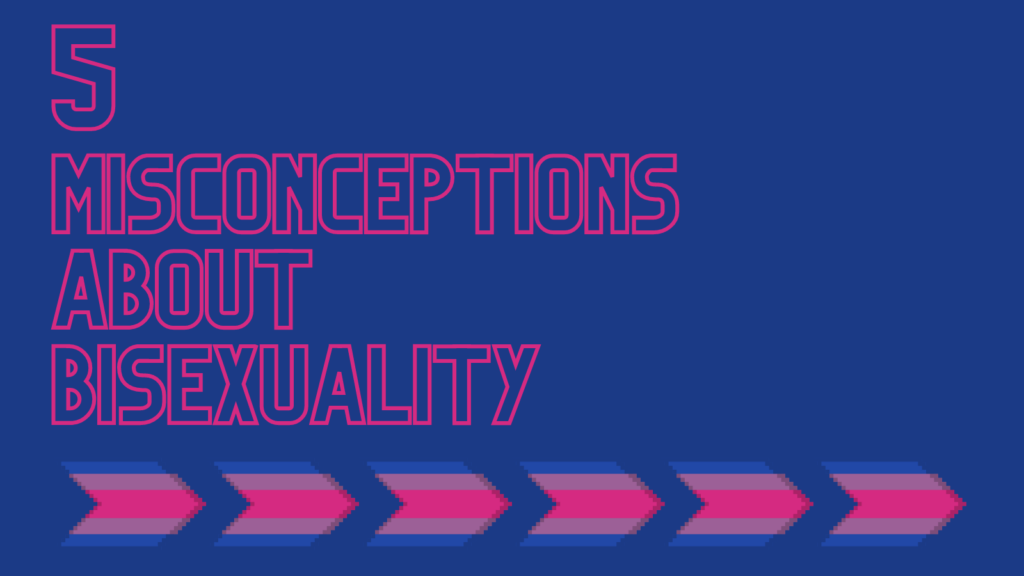
We asked Lois Shearing, author of Bi the Way: The Bisexual Guide to Life, what the most commonly held misconceptions about bisexuality are. Here, Lois smashes these myths and explains why they’re untrue!
While bisexuality and the bi+ community has gained a lot of visibility over the past few decades, there is still lots of misinformation about what it means to be bi in public discourse. Ten of the most common misunderstandings and the questions that arise from them make up the premise of my new book, Bi the Way.
As Pride month draws to a close, here are five of the most persistent misconceptions about bisexuality, busted:
No one is really bisexual
Despite the fact the word ‘bisexual’ has been in popular usage since the mid 20th century, and a bisexual movement has been bubbling since the 70s, plenty of people still believe that bisexuality isn’t actually a real or permanent identity. Thanks to Freud, many people still believe bisexuality is a phase that people go through during sexual immaturity, before settling into a single-gender attraction as they mature.
But this is far from the truth. Bisexuality is just as much of a real, complete and permanent (for many) identity as being gay or straight. In 2019, the ONS found that 1.1% of the UK’s population identify as bisexual, that about 733150 people! Surely we can’t all be wrong?
Everyone is bisexual
Although it might not seem like it, this misconception actually stems from the same assumption as above; that everyone is bisexual but just settles into or chooses a ‘real’ sexuality. Although it may seem validating, the claim that everyone is at least a little bit bi is often used to minimize or even silence bi people when we talk about our needs or experiences. After all, if everyone is bi but just gets on with it, what makes us so special that we feel we need our own separate support, services, community, etc?
Bisexuality is a trend/a modern identity
Whilst it’s true that we are a stylish bunch, the idea that bisexuality is a new phenomenon couldn’t be further from the truth. There has been evidence of multi-gender attracted people all throughout history, from the ancient world all the way up to the 20th century when the term ‘bisexual’ started being applied to people. A few examples of historical figures who may have been bi includes; Shakespeare, Casanova, Virginia Woolf, Colette, Josephine Baker, Mary Wollstonecraft, Lord Byron, and many, many more.
To add to this, even if bisexuality was an identity that wasn’t rooted in millennia of history, it would still be valid. As our understanding of the world and ourselves expands, so too will our concept of sexuality and identity.
Bisexuals weren’t part of the gay liberation movement
Completely, provably false. Although much of the bi community’s contribution to early gay and queer liberation movements has been erased from the mainstream narrative of queer history, bi activists were very much there. For example, the first Student Homophile League in the US, which advocated for LGBT+ rights on campuses, was founded by an openly bisexual man; Donny the Punk. The first Pride March (and even the term ’Pride’ in its popular usage today) was thanks to the work of another bisexual activist, Brenda Howard. Other important figures include Cynthia Slater, who provided safe-sex education in bathhouses during the AIDs epidemic and even founded the first HIV/AIDs phoneline for women, and ABilly Jones, an activist and advocate for black queer men with HIV/AIDS.
Bisexuals don’t face any unique challenges
Perhaps the most damaging misconception beyond ‘bisexuality doesn’t exist’ is that there are no unique bisexual issues. This myth usually stems from the idea that bi people’s identities are partly gay and partly straight, and so we only face (watered-down versions) of the same oppression and marginalisation that gay men and lesbians experience.
Whilst there is a lot of overlap in our experiences and bi+ people certainly face homophobia, there are also a number of challenges that are particularly acute for bisexual people. These include; higher rates of sexual violence than straight/gay people, higher rates of addiction, worse mental health outcomes, and higher rates of poverty. Unfortunately, because of bi-erasure and the misconception that catering to gay people will automatically cater to bi people, there are often fewer or inadequate solutions for the issues that bi people face.
To learn more about bisexuality, check out my book Bi The Way, available now.
Follow Lois on Twitter here. For more content like this, why not join our mailing list?